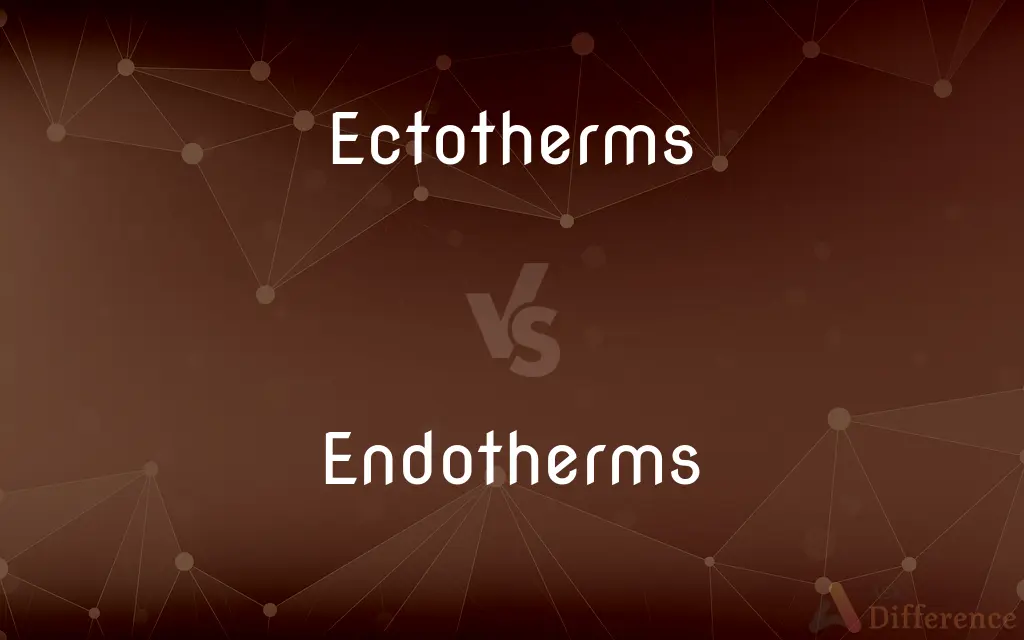Ectotherms vs. Endotherms — What's the Difference?
Edited by Tayyaba Rehman — By Fiza Rafique — Published on December 7, 2023
Ectotherms rely on external sources for body temperature regulation; endotherms generate and maintain their own body heat.

Difference Between Ectotherms and Endotherms
Table of Contents
ADVERTISEMENT
Key Differences
Ectotherms are organisms that primarily depend on external sources to regulate their body temperature. In contrast, endotherms have the ability to generate and maintain their body temperature internally.
An ectotherm's body temperature often fluctuates with the environment. On the other hand, endotherms maintain a relatively constant body temperature irrespective of external conditions.
Ectotherms, due to their reliance on external heat sources, may become inactive in cold conditions. Endotherms, however, can remain active as they can produce their own heat.
The energy expenditure in ectotherms is generally lower because they don't need to constantly produce heat. Endotherms, however, require more energy as they are constantly generating heat.
Ectotherms can often be found basking in the sun to gain heat. Endotherms, conversely, rely on metabolic processes to generate warmth and don't need to bask as frequently.
ADVERTISEMENT
Comparison Chart
Temperature source
External environment
Internal metabolic processes
Energy Efficiency
Generally more energy efficient
Uses more energy to maintain temperature
Activity in Cold
May become inactive
Can remain active
Temperature Range
Often fluctuates with environment
Remains relatively constant
Typical Behavior
Basking in sun to gain heat
Relying on metabolic heat generation
Compare with Definitions
Ectotherms
Ectotherms are animals that regulate their body temperature through external means.
Lizards, as ectotherms, often bask in the sun.
Endotherms
Endotherms are organisms with internal mechanisms for temperature regulation.
Mammals, as endotherms, maintain a consistent body temperature.
Ectotherms
Ectotherms are organisms whose body temperature is determined by their environment.
Fish in the ocean, being ectotherms, change their temperature with the water around them.
Endotherms
Endotherms are animals that produce and regulate their own body heat.
Birds, being endotherms, can fly in cold altitudes without freezing.
Ectotherms
Ectotherms are creatures that don't produce sufficient internal heat.
Amphibians, like frogs, are ectotherms and require external warmth.
Endotherms
Endotherms generate heat through metabolic processes.
Humans, being endotherms, can shiver to produce more heat.
Ectotherms
Ectotherms depend on external conditions to control their temperature.
Being ectotherms, turtles will move to cooler or warmer spots based on their needs.
Endotherms
Endotherms use energy to keep their temperature constant.
Cats, as endotherms, won't become inactive in cold the way some reptiles do.
Ectotherms
Ectotherms are species that rely on environmental heat sources.
Snakes, as ectotherms, can often be found on warm rocks.
Endotherms
Endotherms are species that maintain a stable internal temperature.
Being endotherms, dogs don't rely on sunbathing as much as reptiles do.
Ectotherms
An organism that depends on external sources for its body heat.
Endotherms
An organism that generates heat to maintain its body temperature, typically above the temperature of its surroundings.
Ectotherms
Plural of ectotherm
Endotherms
Plural of endotherm
Common Curiosities
How do endotherms maintain temperature?
Endotherms generate and regulate their body temperature through internal metabolic processes.
Which requires more energy: ectotherms or endotherms?
Endotherms generally require more energy to maintain body temperature.
Why might ectotherms bask in the sun?
Ectotherms bask in the sun to absorb heat and regulate their body temperature.
Do endotherms need to sunbathe for warmth?
Endotherms do not rely heavily on sunbathing for warmth as they generate heat internally.
What is an example of an endotherm?
Humans are an example of endotherms.
How do endotherms adapt to cold environments?
Endotherms adapt by generating more internal heat and having insulating features like fur or fat.
Can ectotherms survive in extreme cold?
Many ectotherms may go into a dormant state or seek shelter in extreme cold.
What are ectotherms?
Ectotherms are organisms that regulate their body temperature using external sources.
Are reptiles typically ectotherms or endotherms?
Reptiles are typically ectotherms.
Do ectotherms have a stable body temperature?
Ectotherms' body temperature often fluctuates with the environment.
Why do endotherms eat more frequently than ectotherms?
Endotherms need more energy to constantly produce and regulate body heat.
Can ectotherms remain active in very cold conditions?
Ectotherms may become inactive in cold conditions due to their reliance on external heat sources.
Are fish ectotherms or endotherms?
Most fish are ectotherms.
Are there any advantages to being an ectotherm?
Yes, ectotherms often have lower energy requirements and can exploit a wider range of habitats during optimal conditions.
Are all birds endotherms?
Yes, all birds are endotherms.
Share Your Discovery

Previous Comparison
Brad Nailer vs. Finish Nailer
Next Comparison
Radiator vs. IntercoolerAuthor Spotlight
Written by
Fiza RafiqueFiza Rafique is a skilled content writer at AskDifference.com, where she meticulously refines and enhances written pieces. Drawing from her vast editorial expertise, Fiza ensures clarity, accuracy, and precision in every article. Passionate about language, she continually seeks to elevate the quality of content for readers worldwide.
Edited by
Tayyaba RehmanTayyaba Rehman is a distinguished writer, currently serving as a primary contributor to askdifference.com. As a researcher in semantics and etymology, Tayyaba's passion for the complexity of languages and their distinctions has found a perfect home on the platform. Tayyaba delves into the intricacies of language, distinguishing between commonly confused words and phrases, thereby providing clarity for readers worldwide.












































